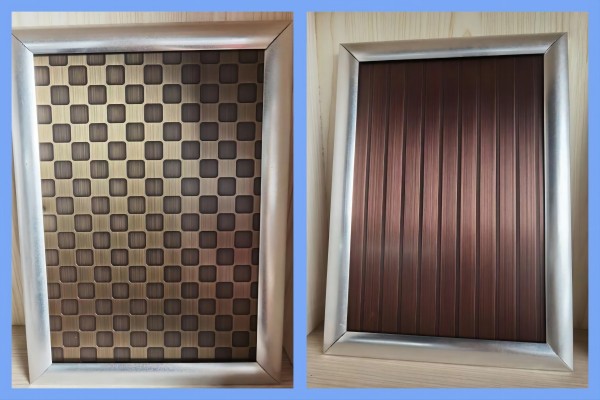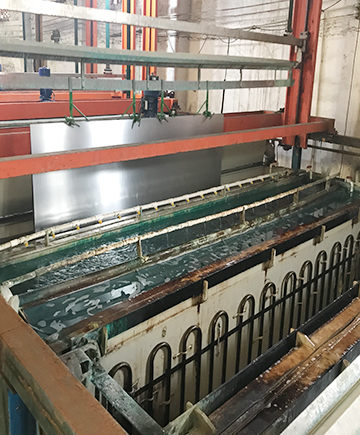Around the globe, the Antique series has gained significant traction in architectural design projects. While genuine copper materials exude luxury, their high costs have driven innovation, leading to the birth of the Stainless Steel Antique Bronze technique. This process not only offers a cost-effective alternative but also brings several advantages:
Aesthetics: The Antique Bronze finish on stainless steel replicates the rich appearance of real copper, adding a touch of elegance to any design.
Maintenance: Stainless steel's inherent resistance to corrosion means that structures using this finish require less maintenance compared to those using real copper.
Versatility: This technique can be applied to various architectural elements, from facades to interior details, offering designers a broader canvas to work with.

Antique Copper Gradient Stainless Steel
Today, we delve deeper into the actual production steps of the Stainless Steel Sheet Antique Finish and the essential precautions to consider.
Stainless steel cyanide copper plating is the earliest and most widely used copper plating process. The plating solution is mainly composed of copper cyanide complex and a certain amount of free cyanide, which is strongly alkaline. Therefore, it is also called chemical copper plating or chemical plating.
Due to the strong activation and complexing ability of cyanide, the first feature of this electroplating method is that the solution has a certain degreasing and activation ability.
Secondly, because this plating solution uses cyanide with strong complexing ability, it makes the complex ions difficult to discharge. Thus, the cathode polarization of the bath is very high, with excellent leveling and covering abilities.

The color surface generally falls into two main categories: red copper and bronze. If brushed technology is added to these two colors, it will produce two different decorative finishes: red antique copper brushed and bronze antique copper brushed.
For a deeper exploration of various Antique finishes, please
click here
to browse.

1. No need for a heat source, various plating works are carried out at normal temperatures of 15-40°C.
2. The principle is not to cover, but to form an alloy by combining the plating layer with the base material, greatly increasing its binding strength. One point worth noting is: chemical plating is polluting.
In the aqueous solution, without relying on an external power source, the reducing agent in the plating solution undergoes a chemical reduction reaction, causing metal ions to continuously reduce on the self-catalytic surface, forming a metal plating layer.
First, roughen the workpiece to be plated, remove wax and oil, activate it, then electroplate with alkaline copper for about 10 minutes, rinse with water after coming out of the bath, neutralize, activate;
Then, bright copper electroplating is carried out. The plating time is more than 20 minutes. When the plating layer is thick enough, it is taken out of the bath for water washing and activation;
Directly electroplate with nickel and black. The plating time depends on the uniform black color on the workpiece surface, then rinse with water, dry, and wait for processing.

The workpiece with bright copper electroplating can also be blackened after washing. Generally, it is soaked in a 5% potassium sulfide aqueous solution, turned over repeatedly, and when the workpiece surface turns black or brown, it is taken out, washed with water, dried, and waited for processing.
Then, the stainless steel sheet that have been plated with black nickel and gun color or have been blackened are polished with a scouring pad. Depending on the requirement for the antique color, the intensity of polishing is controlled. When the SS sheet achieves the desired effect, it is sprayed with electroplating varnish, which is what we call
anti-fingerprint treatment (AFP)
, and then dried and packaged.
The formation of surface verdigris: Chemical-plated copper is a real copper layer plated on the surface of stainless steel; when anti-fingerprint treatment is done after copper plating processing, the edges and corners are difficult to be covered by Antique Finger Print Coating; shearing and welding damage the surface's fingerprint-free oil layer; all of these can lead to the product producing verdigris! So after the plate is processed and assembled, it is best to spray a layer of fluorocarbon paint. In short: only real copper will produce verdigris.
The formation of black spots on the plate surface: There are hidden sand holes on the surface of the stainless steel plate, which are covered after copper plating processing, and sand holes will also be produced during the drawing process. After washing and drying, there will be residual moisture, which is covered by the
fingerprint-free coating (AFP)
. After a period of time, small black spots will appear.
The coating (AFP) on the surface of the stainless steel copper-plated plate has a good protective effect on the internal material of the plate. If the surface paint is scratched or even peeled off, causing the raw material to be exposed to the outside for a long time, it will react with the oxygen in the air to produce copper rust and black spots, affecting the appearance. Therefore, during use, it is strictly forbidden for hard and sharp objects to collide with this decorative plate.

Avoid direct contact with this product with highly oxidative and corrosive chemicals. If chemicals accidentally come into contact with the product surface, please rinse it off immediately with clean water, wipe the water dry with a cotton cloth, and then spray the cleaner on the product surface for cleaning and maintenance.
During the decoration process, do not rush to remove the protective film on the stainless steel surface finish to prevent the product from being damaged. Because the cement and paint that fall on the antique copper-plated product during painting will cause the copper-plated product to produce black spots and rust; if your wall needs to be cleaned, please seal and protect it with plastic film before cleaning the wall. Because the chemicals used to clean the wall (especially the marble wall), such as oxalic acid, will severely damage the product, it is strictly forbidden for such substances to come into contact with the product surface.
After the product is installed in the project, please tear off the protective film on the product surface within 30 days to avoid the protective film sticking to the product and affecting its appearance.
Copper-plated products should avoid being exposed to rain and direct sunlight as much as possible. If they are often exposed to rain or direct sunlight, the appearance life of the copper-plated product will be shortened. If the product is installed outdoors and may be exposed to rain or direct sunlight, it is recommended that customers install a rain shed.

The Stainless Steel Sheet Antique Finish is more than just an alternative to genuine copper; it's a testament to how innovation can bring about solutions that are both aesthetically pleasing and economically viable. As architectural trends evolve, techniques like these ensure that designers have the tools they need to realize their visions without compromising on quality or budget. For those interested in learning more about this revolutionary process or seeking consultation on its application, we invite you to reach out to us. Additionally, we offer support for sample matching to produce finishes tailored to your specific needs. Let's explore the future of design together.
By continuing to use the site you agree to our privacy policy Terms and Conditions.